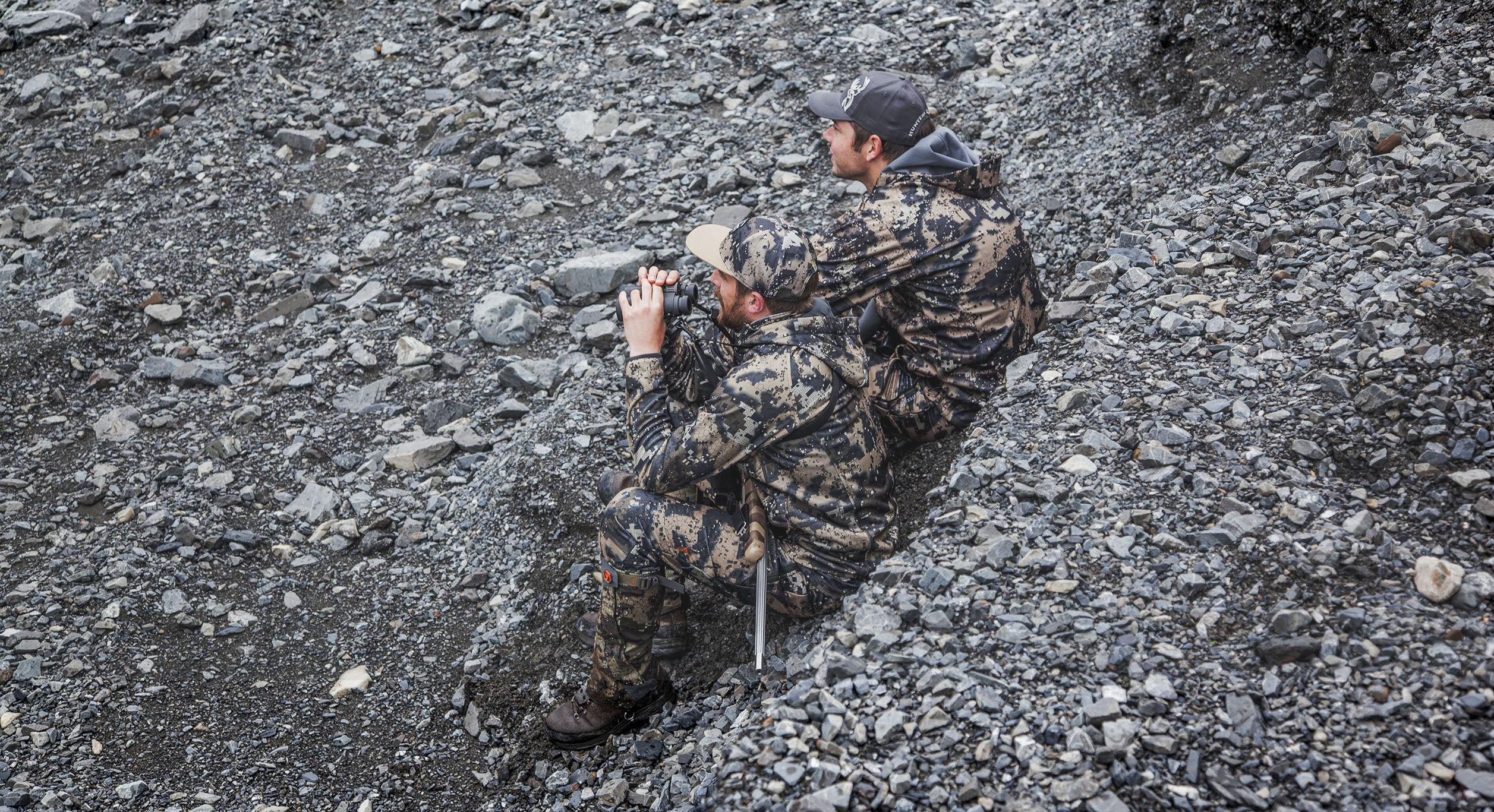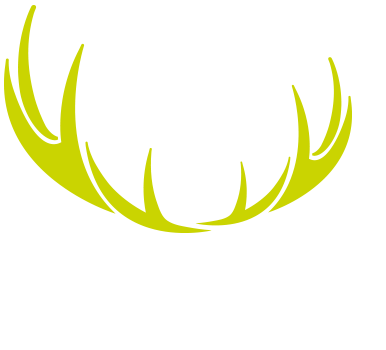
DESOLVE CAMOUFLAGE
THE FULL STORY BEHIND THE HUNDREDS OF HOURS OF RESEARCH
OVERVIEW
In early 2014 our curiosity sent us down a path of research and development that lead to the creation of Desolve Camouflage, a pattern designed to fool animals, not hunters. Our research highlighted the massive problems with current “sticks and leaves” styles of camouflage. Ungulates (hooved animals) don’t see the way we do, instead their vision is blurrier so they don't focus on detail, instead they have been trained to focus their attention on outline. A new style of camo that breaks up this outline with large macro and micro shapes creates the illusion of depth, so the subject appears to be a series of small objects spread out across a range of distances. Desolve Camouflage was developed and tested in the field over the course of hundreds of hours to manipulate the specific colour and light tones most prominent to ungulates and the results are simply astonishing.

WHY WE MADE DESOLVE CAMOUFLAGE
The creation of Desolve Camouflage was born purely out of curiosity. We are passionate hunters and we’ve always had a drive to find bigger trophies, make longer shots, get closer and understand the animals better. It seems that almost every hunter has a story about watching a deer in clearing, sitting dead still in the shade, down wind and hundreds of yards away, and all of a sudden that deer looks up and stares straight at them. These stories combined with the never clear stories about UV light and enhanced vision dragged us on to the internet to try and figure out what exactly was going on with animal vision and how could we improve what we were doing to hide ourselves from it. What we found spurred us into action to make some drastic and urgent changes to the way we produced camouflage.

THE RESEARCH PHASE
SOURCES
When it came to embarking on the major task of researching the properties of animal vision, we started by setting out some clear parameters around the process in order to try and remain as objective as possible. We believed that this would be crucial in achieving the best results for the development phase. This may seem obvious but it’s important to consider that we were all deep in the hunting world already and had likely formed biases in how we expected the vision and patterns to work based on personal experiences, whether we knew it or not. In short, the research was conducted by collecting over 50 sources of seemingly credible reports and articles both secondary and primary. The two criteria that we bound ourselves to were A; They must have come from a qualified scientific background directly in the field of ungulate vision and B; The studies or papers must have been published since the year 2000. From here we aligned all the research and extracted all the commonalities in the findings and excluded all the contradictory conjecture. This left us with clear objective findings that we could now directly apply to the development phase of our new camouflage pattern.
Much of the research we used was long and quite technical in nature. However, listed below are links to some of the easier to read, straight to the point websites and articles that may be of interest:
New York Times
The Free Library
North Country Whitetails
The Outdoor Channel
THE COLOURS THAT ANIMALS SEE
Most all animal’s eyes are made up of a series of internal rods and cones. Each of these serves a function of interpreting light as shape and colour. Ungulates or hooved animals have been determined to lack the cones required to easily discern colours in the red spectrum. From this we can determine that that they are effectively red-green colour-blind. This means that most shades of greens, browns, yellows, oranges and reds are all seen as one similar colour to deer. This is why hunters are able to wear bright blaze orange clothes without standing out from the natural surrounding environment. However, it should be noted that the other side of the colour table, blue, can be determined as extremely out of place to a deer just as it is to the human eye.

ULTRA VIOLET (UV) LIGHT
UV light can most easy be thought about from our perspective as a type of glowing light. The Human eye has a built in filter which blocks out about 99% of UV light. If that filter wasn’t in our eyes we would see some short-wave length colours stand out from the crowd like something shiny reflecting in the sun light. The best example we can see of UV light is when looking at neon paints or bright white T-Shirts that glow in nightclubs under black lights. Ungulates do not have this filter covering their eyes, meaning these colors in the UV spectrum glow a lot brighter, especially in low light conditions. This UV glow doesn’t naturally occur very often in the natural environment. A lot of modern dyes and laundry products used in the creation and washing of hunting clothing contain color brighteners which in fact are UV enhancers. As a lot of hunting clothing manufacturers are unaware of this and this may be why experienced hunters will often swear to have had more success at getting close to deer in their old “worn in” hunting clothes.

DEPTH PERCEPTION AND CLARITY
Obviously most hooved animals have their eyes located more on the side of their heads than humans. The advantage to this is that they have a field of vision that spans about 270 degrees, compared to the humans 140 degrees of vision. The downside to this though is that the clarity with which they see is diminished. Now this is where it gets a bit technical and theoretical depending on which study you look at.

The main thing that we really need to know though is that both the detail and clarity are reduced in ungulate vision compared to human vision. The easiest way to think of this is to imagine that deer see a slightly blurry image, as if they need glasses. Now because of this they identify their potential threats based primarily on outlines and shapes. They are hard wired to identify harsh outlines of objects and symmetry in these outlines. So for example a tigers silhouette has a sharp outline too it compared to a broken up bush with thousands of small leaves. Also the tiger facing front on to the prey will also have a nice symmetrical shape to it. Both of these elements set off a warning signal to the prey. Now this is probably the most important point when we think about camouflaging ourselves from our prey. This tells us that the detail and realism of the leaf and stick shapes in the camouflage pattern aren’t actually very important as they aren’t able to be clearly defined by an ungulate anyway. What is important, is our outline!

DISRUPTION VS MIMICRY
The majority of the hunting camouflage scene is saturated with what we can call “mimicry” patterns. These use pictures or photos of sticks, leaves, bark, trees, etc. These mimicry patterns naturally look the best to the human eye. Because our vision is so much sharper than that of ungulates, we interpret the detail as matching that of the environment it is meant to mimic. Unfortunately, as discussed above, this is the wrong approach to take when trying to fool a deer. Although we see this fine detail, the ungulates do not. With their cloudier vision, they perceive these sticks and leaves as blobs of blurry colour. So they will see a bush on a hillside as a green blob, or a twig as a brown bar. They will see these mimicry camo patterns as big brown blobs as well as they these patterns only use low contrast, micro patterns. So unfortunately all that nice detail in the camo is lost on a deer. What they do see then is a brown blob with a defined outline, just as we would if we were to look at another hunter dressed in a solid brown jersey. Disruption is therefore the key to fooling ungulates into not seeing us. Disruption in camouflage terms refers to breaking up this vitally important outline. Disruption will in essence trick the animals eyes into not recognising the subject as one single object. Instead it will use different sized patterns to create the illusion of depth. To the animal it will look as though one part of the pattern is a small object 50 meters away, and another part of the pattern is a small object 200 meters away, for example. Based on the science behind their vision, this will be a far more effective and logical approach than trying to trick them into believing that one big object is something that it is not. In essence, mimicry camo tries to trick the animal to believe that the subject is something that it isn’t, where disruption camo tricks the animals eyes into not seeing any subject at all.


